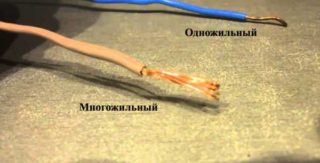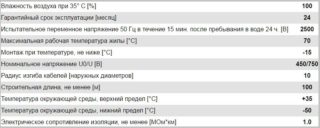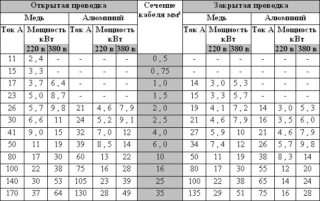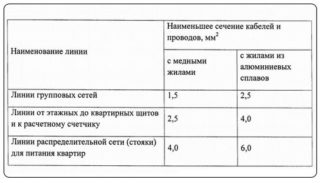PV 3 is a copper power conductor that is insulated with PVC (polyvinyl chloride). It is used in many devices and electrical circuits - various devices, household appliances, light networks, etc. The main difference from previous models is increased flexibility, which is especially important when laying complex wiring. It has certain characteristics and parameters, which can be clarified by marking on the outside.
What does labeling mean?
The cable is used in different situations - wiring, devices, devices. There are different types and types of wires, the characteristics of which are indicated on the outside (on the "rubber" part). Symbols - letters, numbers, signs - allow you to define:
- the number of veins inside and their material;
- insulating type;
- section - the cross-sectional area of the element is from 3.5 to 24 cm squared;
- permissible voltage - nominal values of electrical indicators;
- attitude to environmental influences - humidity, heating;
- features of the internal structure;
- flexibility - usually marked with numbers from 1 to 6, PV3 wire has an average value.
Design features are also reflected in the marking. For example, monolithic or multiwire internal element, the presence of insulation. Additionally, the type is indicated - wire, cable or cord.
GOST and design differences
In the last part of the marking indicate the recommended temperature level for operation and the number of technical documentation - GOST or TU. The latter contain information about the methods and techniques for making wires. Manufacturers are required to indicate the GOST number, TU, but in recent years they “forget” to do this because they rarely adhere to the recommended parameters.
The wire assembly PV 3 is single-core, multiwire. The material is copper. Thanks to these characteristics, the cable conducts electricity well, bends easily in different directions, does not deform. Marking is deciphered as follows:
- P - means the type of "wire";
- B is an isolation option, in this case polyvinyl chloride;
- 3 - flexibility class.
Technical characteristics allow the use of the PV-3 cable in different conditions and devices, including with high humidity.
PV3 wire construction elements
Each cord or cable has certain design features. The type and number of elements is affected by the purpose, operating conditions, and the level of maximum voltage. The structural details of the PV 3 installation wire are:
- copper core (according to GOST No. 22483 can be solid or multiwire);
- external protection (insulating layer).
Despite the minimum number of elements, the wire has high technical characteristics, due to which it is used in various fields. For example, the grounding cable PV 3 is used in residential buildings and electrical devices.
Technical characteristics of the PV-3 wire (PuGV)
If the cable needs to be laid in a limited area (electrical panel, wiring inside the devices), it is important to use soft multi-wire cables of the PuGV class, which also includes PV-3. The characteristics of such wires are typical:
- permissible AC voltage 450 to 750 V, for DC - up to 1000 V; frequency up to 400 Hz;
- possible humidity level - up to 98%;
- temperature limit for installation work - minus 15 ° Celsius;
- flexibility - up to 5 diameters of the whole section;
- wire insulation remains operational at temperatures up to 160 ° Celsius;
- possible cross-sections of PV-3 wires - from 0.05 to 40 square cm.
The service life of cables with standard characteristics depends on the operating conditions, environmental parameters and installation method. Usually a maximum limit of 15 years is indicated. In “aggressive” conditions, the term can be reduced to two years. For example, if the PV-3 wire is laid in an open way, it is subject to constant exposure to ultraviolet radiation, precipitation, and temperature changes. The average warranty period is 1 year.
Wire routing conditions
The PV-3 cable is mounted in different conditions, subject to certain recommendations. If the ambient temperature is below 15 ° Celsius, the wire must be warmed up. Otherwise, damage and cracking during bending cannot be avoided.
It is important to observe the permissible bending limits - not more than five external diameters. PV-3 has medium flexibility, so it is not recommended to create excessive pressure.
An additional point - do not allow condensation or moisture to enter the inner core.
Conditions under which the use of PV-3 wire is allowed
The soft PuGV cable can be used in different conditions. Specifications make it possible to lay the wire in rooms with high humidity (bathrooms, baths). Much depends on the type of wiring - open or closed. The insulating layer maintains its performance under sharp temperature fluctuations (from -60 ° to + 70 ° Celsius).
PuGV wire load currents
None of the current GOSTs sets the permissible limits of the load currents of the PuGV cable. Therefore, the Electrical Installation Rules are applied - several regulatory documents developed by the Ministry of Energy of the USSR and Russia (the requirements are common for all countries). The maximum current level depends on the cable cross-section. For example, for a wire with a diameter of 0.75 square mm, the limit is 15A of the load, and for a cross section of 5 square cm - 215A.
Application area
On the one hand, the PV-3 cable has a wide field of operation and application, on the other hand, it can not always be used. The wire is single-core, which significantly reduces the scope. For example, for electrical wiring, in most cases it is recommended to lay multicore cords. According to GOST PV-3 is suitable for:
- electrical wiring, lighting;
- connecting electrical appliances and installations in residential and non-residential premises.
The cable is not power, therefore, it is not suitable for the same types of installation, two and three-phase connections. Here you need a cable with two and three cores, respectively.
The main purpose of the PuGV cable is grounding, where a single-core wire is enough. If the main cable requires additional flexibility, you can use several PV-3 wires twisted together. In rare cases, soft cords are connected to power cabinets and automatic machines in production.
Purchase Check
Manufacturers rarely adhere to established standards of GOST and TU. Therefore, the market for electrical goods is filled with fake products. In most cases, such wires lead to short circuits, power surges, fires. Therefore, before buying, you must carefully check the packaging, manufacturer, store (supplier).
Key recommendations:
- select products with GOST marking - the designation is at the end of a number of characters on the cable;
- there must be a special sticker on the packaging material;
- marking symbols should be located along the cable length - average step - 0.5m;
- check the correspondence of the parameters of the section - you can use the caliper;
- check the documentation - the seller must provide certificates confirming the quality of the products.
Professionals recommend periodically checking the operation of the cable using force tests.
Cable Selection Guide
To choose a wire for the network, you need to decide on several parameters - cross-section, material, brand. The most common materials are copper and aluminum. Copper has better conductivity and is not subject to corrosion. Aluminum is a soft material; a quick break occurs in strong bends of cables. In contact with air, aluminum quickly oxidizes, an oxide film forms on the surface. Such a film does not pass the current signal well, and provides unreliable contact.
The defining section parameter is diameter (d). At low currents, a copper core is used with a diameter of more than 1 mm2, aluminum - 2 mm2. When working with large currents, the diameter is selected based on the power of the network. The selection of the diameter is made according to the table. 3, given the laying of the cable through the pipe or open.
Errors when using the PV-3 cable
If the PV-3 wire is laid independently, some features and common errors should be taken into account. First of all, it is necessary to check the compliance of the cross sections of the inner core and the whole cable. If the diameter is smaller, do not avoid overload and burnout.
Do not allow contact between the inner conductors of the wires. More often this happens when the two-key and three-key types are connected. In this case, there will be a simultaneous closure of the two networks, and consequently - a malfunction, lack of voltage, fire.
Soft single-core cable PV-3 is used in various conditions. The range of cross sections and voltage level allows laying external and internal methods. Stranded wires are used for complex systems.











